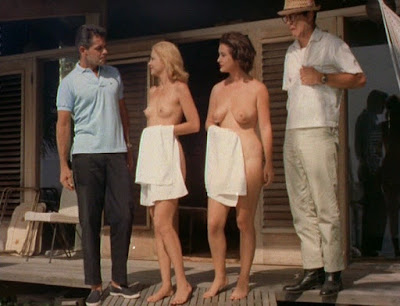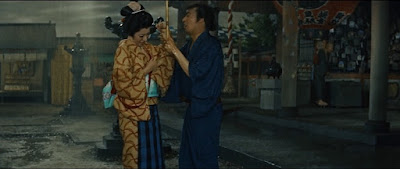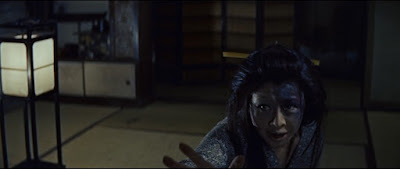Early on there is perhaps some doubt about its genre categorisation but it does get more and more giallo-esque as it goes.
Naschy is Gilles, a drifter looking for a job. The suggestion is made that the three sisters who live in a big house on the outskirts of the village might employ him, although the way the suggestion is put could lead one to suspect that working for the sisters might not be the best of ideas.
Naschy is Gilles, a drifter looking for a job. The suggestion is made that the three sisters who live in a big house on the outskirts of the village might employ him, although the way the suggestion is put could lead one to suspect that working for the sisters might not be the best of ideas.
He gets the job anyway and it’s a live-in job.
The eldest sister Claude (Diana Lorys) has a badly disfigured arm as the result of an accident. She is convinced that men now find her repulsive. Her sister Ivette (Maria Perschy) is wheelchair-bound, presumably as the result of the same accident. And then there’s the man-hungry Nicole (Eva León).
The sisters all take note of Gilles’ manly physique when they see stripped to the waist chopping firewood. They like what they see. So now we have Gilles living in a house with three women. They all seek potentially dangerous. All three seem crazy. And, for very different reasons, Claude and Nicole are so sexually frustrated that they’re climbing the walls.
Gilles is by no means immune to their feminine charms.
Then the nurse arrives and there’s something about her that makes us wonder if she’s everything that she seems to be.
A guy suddenly turns up and tries to kill Gilles.
Three cute teenage backpackers arrive in the village. They’re looking for fun. These girls spell fun M-E-N.
Gilles has disturbing dreams, or perhaps they’re flashbacks.
There’s plenty of potential now for mayhem, and there’s a brutal murder. It won’t be the last murder.
There are at least half a dozen very plausible suspects. All of these people are either twisted in some way, or we suspect that they may be twisted in some way. Their motives might be rational or totally irrational.
As usual with his movies Paul Naschy wrote the screenplay and for the most part he plays fair with us. The resolution gets a bit wild and outrageous but it works. For me a successful mystery story is one in which I find the ending believable because the clues pointing in the right direction were there and it feels psychological plausible. That’s the case here. There’s a respect for the conventions of the mystery genre, and that’s not always the case with a giallo.
There is some gore and there are some disturbing moments.
There’s not much in the way of nudity and sex but there is an all-pervasive atmosphere of unhealthy eroticism, and that applies to both the male and the female characters.
Naschy’s performance is very good. He is able to convince us that GiIles is a decent good-natured guy and he’s also able to convince us that there’s at least the possibility of some inner darkness. All of the performances are solid with Diana Lorys and Maria Perschy being particularly good. And Eva León as Nicole oozes sex is a delightfully over-the-top way.
Carlos Aured was the director and co-writer and he worked with Naschy several times. He does a fine stylish imaginative job here. The house in which the three sisters live is a perfect setting for a giallo and Aured takes every advantage of it.
Blue Eyes of the Broken Doll is a top-tier giallo. Highly recommended.
The transfer (in Shout! Factory’s Paul Naschy Collection Blu-Ray set) is in the 1.37 aspect ratio which is possibly incorrect but it looks OK.
I’ve reviewed Naschy’s other foray into the giallo genre, A Dragonfly for Each Corpse (1975), and it’s very much worth seeing.
The eldest sister Claude (Diana Lorys) has a badly disfigured arm as the result of an accident. She is convinced that men now find her repulsive. Her sister Ivette (Maria Perschy) is wheelchair-bound, presumably as the result of the same accident. And then there’s the man-hungry Nicole (Eva León).
The sisters all take note of Gilles’ manly physique when they see stripped to the waist chopping firewood. They like what they see. So now we have Gilles living in a house with three women. They all seek potentially dangerous. All three seem crazy. And, for very different reasons, Claude and Nicole are so sexually frustrated that they’re climbing the walls.
Gilles is by no means immune to their feminine charms.
Then the nurse arrives and there’s something about her that makes us wonder if she’s everything that she seems to be.
A guy suddenly turns up and tries to kill Gilles.
Three cute teenage backpackers arrive in the village. They’re looking for fun. These girls spell fun M-E-N.
Gilles has disturbing dreams, or perhaps they’re flashbacks.
There’s plenty of potential now for mayhem, and there’s a brutal murder. It won’t be the last murder.
There are at least half a dozen very plausible suspects. All of these people are either twisted in some way, or we suspect that they may be twisted in some way. Their motives might be rational or totally irrational.
As usual with his movies Paul Naschy wrote the screenplay and for the most part he plays fair with us. The resolution gets a bit wild and outrageous but it works. For me a successful mystery story is one in which I find the ending believable because the clues pointing in the right direction were there and it feels psychological plausible. That’s the case here. There’s a respect for the conventions of the mystery genre, and that’s not always the case with a giallo.
There is some gore and there are some disturbing moments.
There’s not much in the way of nudity and sex but there is an all-pervasive atmosphere of unhealthy eroticism, and that applies to both the male and the female characters.
Naschy’s performance is very good. He is able to convince us that GiIles is a decent good-natured guy and he’s also able to convince us that there’s at least the possibility of some inner darkness. All of the performances are solid with Diana Lorys and Maria Perschy being particularly good. And Eva León as Nicole oozes sex is a delightfully over-the-top way.
Carlos Aured was the director and co-writer and he worked with Naschy several times. He does a fine stylish imaginative job here. The house in which the three sisters live is a perfect setting for a giallo and Aured takes every advantage of it.
Blue Eyes of the Broken Doll is a top-tier giallo. Highly recommended.
The transfer (in Shout! Factory’s Paul Naschy Collection Blu-Ray set) is in the 1.37 aspect ratio which is possibly incorrect but it looks OK.
I’ve reviewed Naschy’s other foray into the giallo genre, A Dragonfly for Each Corpse (1975), and it’s very much worth seeing.












































